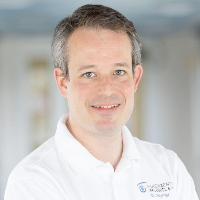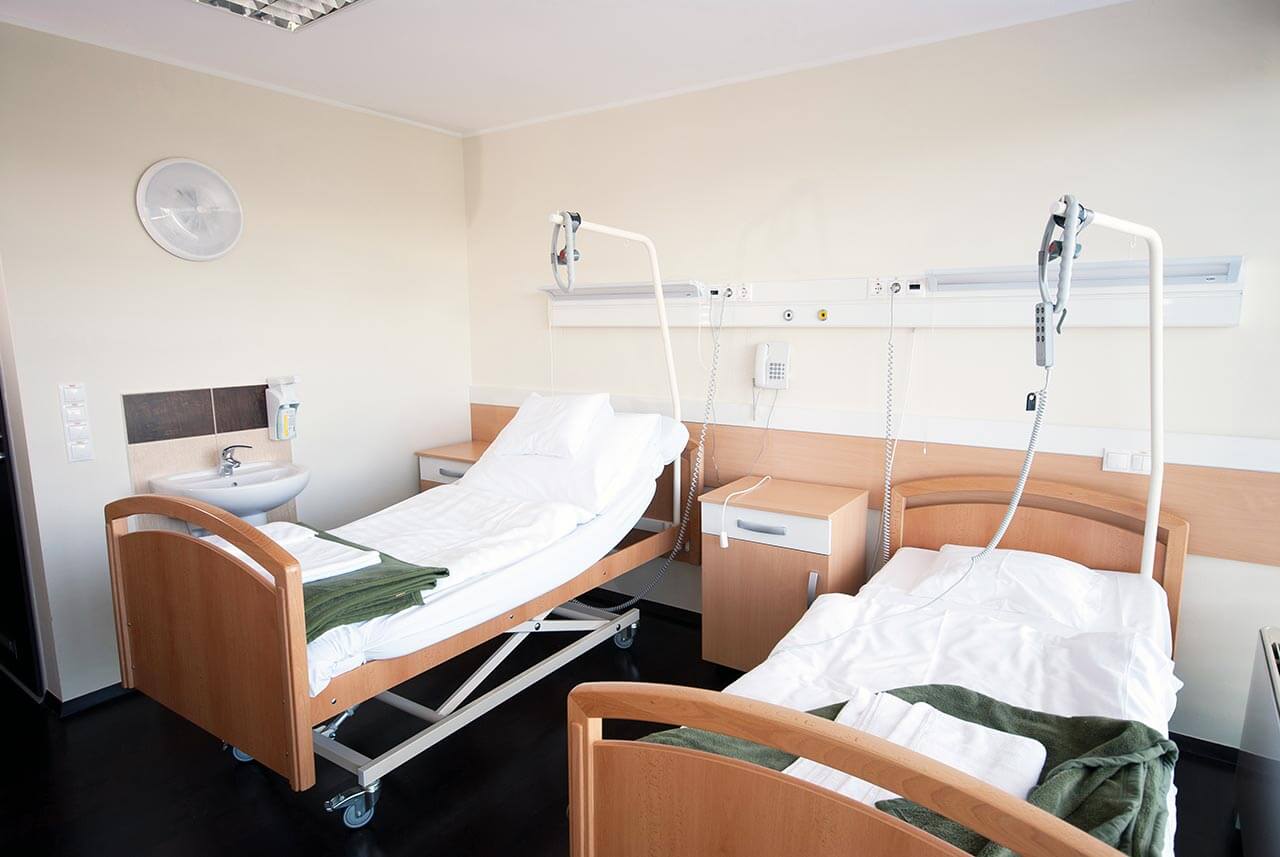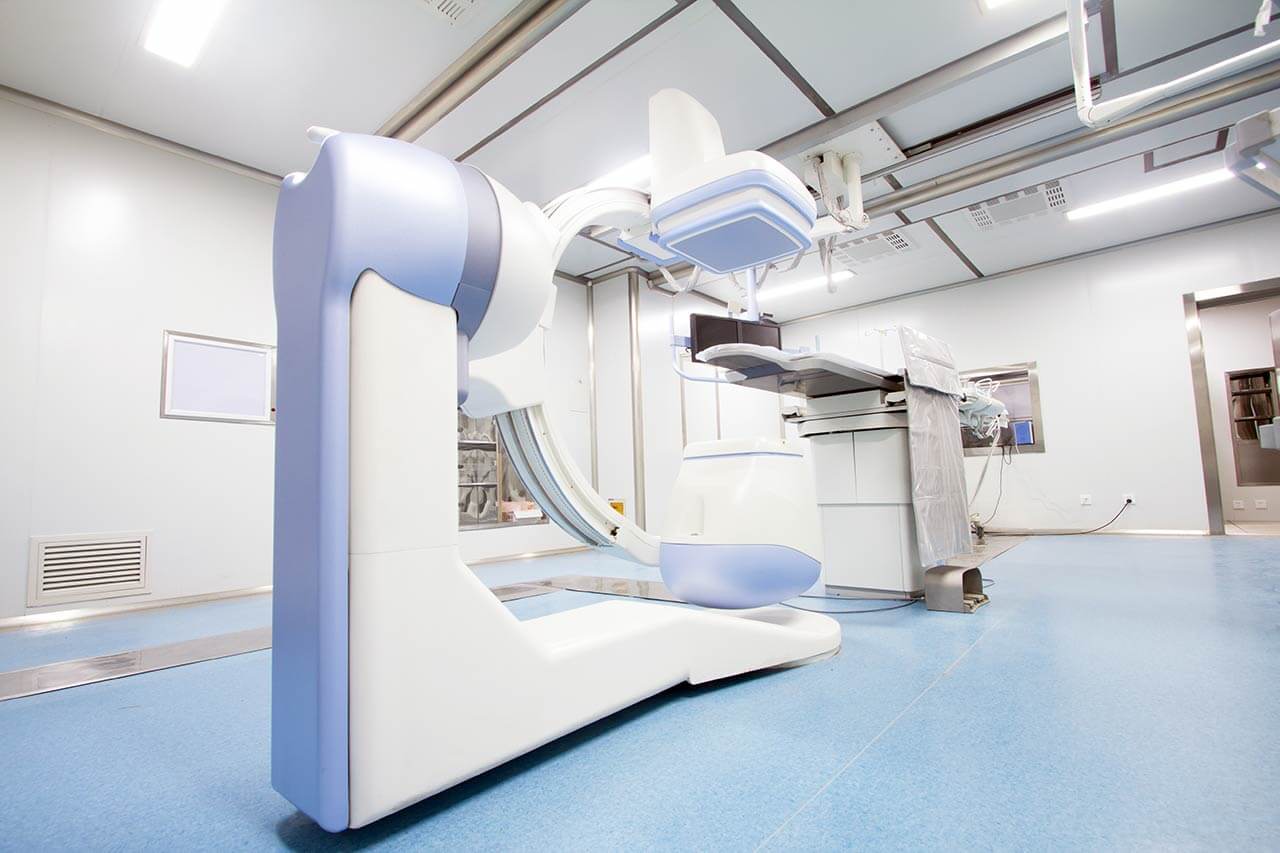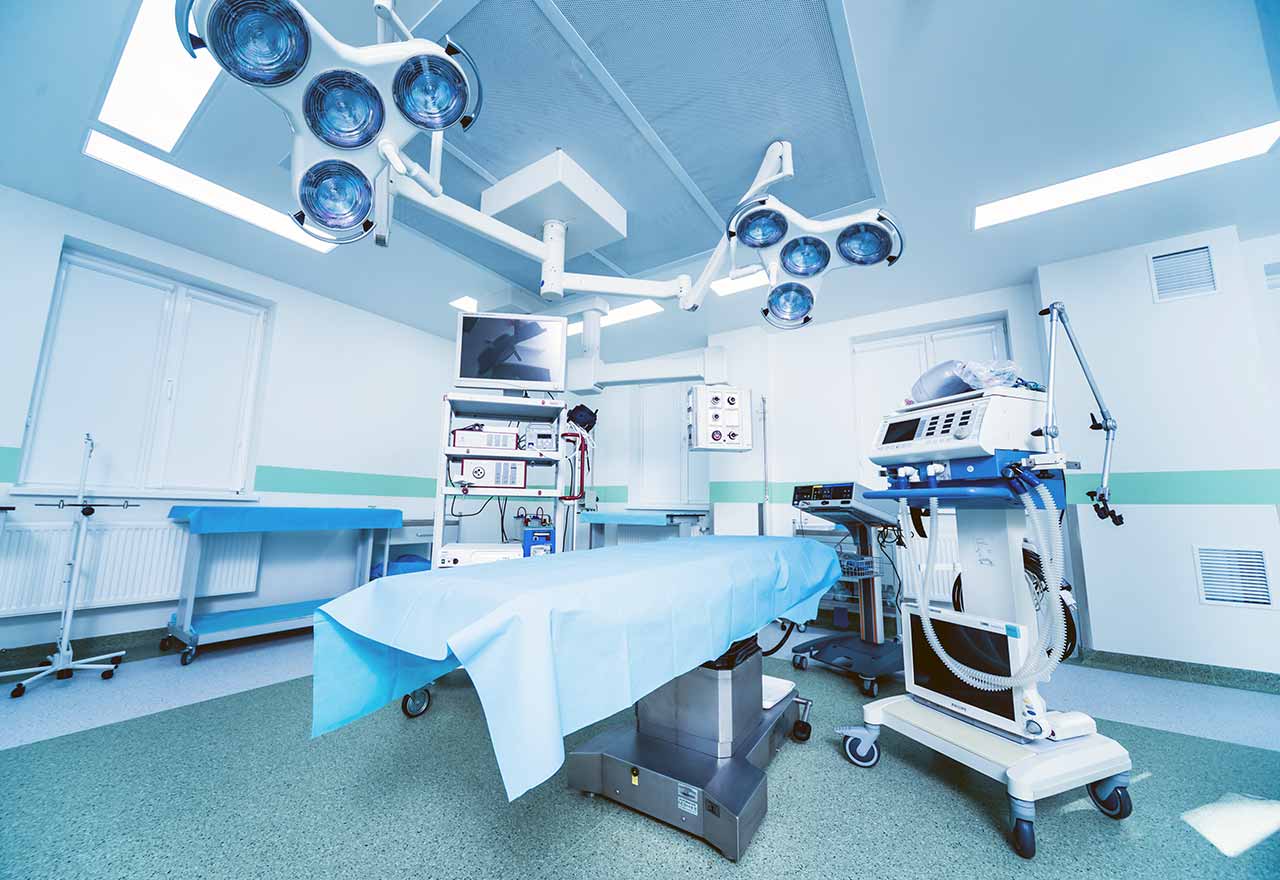
The program includes:
- Initial presentation in the clinic
- clinical history taking
- review of medical records
- physical examination
- ophthalmological examination:
- slit lamp examination
- pupil examination
- ocular motility examination
- ophthalmoscopy
- perimetry (visual field test)
- computer perimetry
- visometry (without correction and with correction)
- keratometry
- pachymetry
- refractometry (objective, subjective, cycloplegic)
- autorefractometry
- non-contact tonometry
- fluorescein angiography (if indicated clinically)
- optical coherence tomography OCT (if indicated clinically)
- gonioscopy
- photokeratoscopy
- nursing services
- services of chief physician and all leading experts
- explanation of individual treatment plan
Required documents
- Medical records
Service
You may also book:
 BookingHealth Price from:
BookingHealth Price from:
About the department
The Department of Adult and Pediatric Ophthalmology at the Hospital Oberberg Waldbrol offers high-precision diagnostics and comprehensive treatment of eye diseases. Special attention in clinical practice is paid to cataract surgery, treatment of glaucoma, treatment of retinal diseases, laser vision correction, and monitoring of patients with diabetes mellitus. The department provides medical care for children and adolescents with strabismus and other vision impairments. Patients are diagnosed and treated on an outpatient basis. The department has state-of-the-art diagnostic equipment, with the help of which doctors can assess the state of vision and anatomical structures of the eye. The department also has cutting-edge surgical and laser equipment, so patients are provided with highly effective and, at the same time, as safe as possible treatment. The professionalism and clinical experience of the department's ophthalmologists deserve special attention. The specialists have successfully performed thousands of surgical interventions and laser procedures, which have allowed patients to see the world in bright colors again. The department has a pleasant and friendly atmosphere, and there are the most comfortable conditions for the patient. The Head Physician of the department is Dr. med. Philipp Heymer.
The department's team of ophthalmologists specializes in the treatment of cataracts, one of the most common eye diseases that may potentially lead to complete blindness. This eye disease causes partial or total clouding of the lens of the eye. Cataracts are common among people over 60 years old. However, the disease also affects young children. The main symptoms are blurring of contours, dimming and fading of colors, increased sensitivity to bright light, and deterioration of vision at night. Cataracts are not amenable to drug therapy because medicines can only slow down the clouding of the lens for a while, but the pathological process cannot be reversed. So it is only a matter of time before cataract surgery is performed, and sooner or later the patient will have to decide to undergo an operation. The most effective treatment method for cataracts is phacoemulsification. The department's doctors perform the surgical intervention using both classical open and sparing laser-assisted techniques (with the help of a femtosecond laser). It goes without saying that priority is given to sparing laser procedures whenever possible. At the first stage of the operation, the ophthalmologist removes the clouded lens, and at the second stage, the lens is replaced with an artificial intraocular lens (IOL). More than 1,500 cataract phacoemulsification procedures are performed in the department every year, so the specialists have vast experience in this field. The surgical intervention is performed on an outpatient basis under drop anesthesia. The duration of the operation is only 15-20 minutes. The department's specialists work with artificial lenses from the world's leading manufacturers. Before the operation, the doctor consults the patient on the choice of an intraocular lens, taking into account the particular clinical case and needs of the patient.
Glaucoma treatment is also of particular clinical interest to the department's physicians. This ophthalmologic disease is associated with a violation of aqueous humor outflow from the eye and causes a persistent increase in intraocular pressure, which leads to irreversible damage to the optic nerve. Glaucoma is considered a dangerous eye disease because the pathology does not cause any symptoms in its early stages, but in the absence of timely treatment, it may lead to irreversible blindness. After the establishment of the diagnosis, doctors start the treatment immediately. The first-line treatment for the early stages of glaucoma is drug therapy with eye drops to normalize intraocular pressure. When this type of treatment is ineffective or inadvisable, the department's ophthalmologists consider laser treatment (laser iridotomy). During the laser procedure, ophthalmologists create a small opening in the iris to improve the aqueous humor outflow from the posterior chamber of the eyeball to the anterior chamber. Laser iridotomy can normalize intraocular pressure and preserve vision. The procedure usually takes only a few minutes. It is performed under local anesthesia on an outpatient basis.
The department regularly admits patients with diabetic retinopathy, which is one of the most severe complications of diabetes mellitus. Against the background of elevated blood glucose levels, the patient's blood vessels are damaged, as a result of which their walls become permeable and fragile. The blood vessels supplying oxygen and nutrients to the retina are also affected, which subsequently leads to poor visual acuity. The progression of diabetic retinopathy may provoke the development of retinal detachment and glaucoma. These diseases can cause complete blindness. The most common complaints of patients with diabetic retinopathy include blurred vision, severe vision impairment, eye floaters, and distortion of lines and objects. The course of treatment is developed individually for each patient. The choice of therapeutic measures depends on the stage of the disease, the degree of compensation for diabetes mellitus, the presence or absence of macular edema, and other factors. First of all, doctors consider drug therapy, including intraocular injections of anti-VEGF drugs. In more complex cases, vitrectomy or laser photocoagulation of the retina is most commonly performed. These microsurgical interventions are performed on an outpatient basis.
The department's range of medical services includes the following:
- Diagnostic examinations
- Optical coherence tomography
- Digital fundus photography
- Examination of the anterior segment of the eyeball with the Pentacam device
- Examination of the corneal curvature radius using the Verion device
- Endothelial microscopy
- Corneal topography
- Optical biometry
- Ultrasound scanning
- Determination of intraocular pressure for glaucoma prevention
- Perimetry
- Pachymetry
- Heidelberg retinal tomography
- Surgical treatment
- Cataract surgery
- Cataract phacoemulsification with follow-up intraocular lens implantation
- YAG laser vision correction in cases of secondary cataract development after cataract surgery
- Glaucoma surgery
- Laser iridotomy
- Argon laser trabeculoplasty
- Ciliary body cryocoagulation
- Trabeculectomy
- Micro-stent implantation
- Refractive surgery: treatment of myopia, hyperopia, astigmatism, and presbyopia
- Femto LASIK procedure
- LASEK procedure
- Refractive lens replacement
- Placement of implantable contact lenses (phakic lenses)
- Intraocular lens implantation
- "Bioptics" refractive surgery
- Blepharoplasty: eyelid and eye area correction surgery
- Ectropion repair
- Entropion repair
- Removal of benign and malignant eyelid neoplasms
- Aesthetic repair of eyelids and eye area (for example, age-related changes, bags under the eyes, etc.)
- Injection therapy (intraocular injections) for vitreous diseases, age-related macular degeneration, diabetic macular edema, macular edema after venous thrombosis, and uveitis
- Cataract surgery
- Pediatric ophthalmology
- Special eye movement and position testing
- Preventive eye examinations in infants and young children
- Amblyopia repair
- Strabismus repair
- Selection of glasses and contact lenses
- Other ophthalmology services
Curriculum vitae
Higher Education and Professional Career
- 2004 - 2011 Medical studies, Faculty of Medicine, University of Bonn.
- 2010 One-year internship, Moorfields Eye Hospital, London.
- 2012 - 2017 Assistant Physician, Department of Ophthalmology, University Hospital Bonn.
- 2014 Thesis defense. Subject: "Study of the effect of ultraviolet radiation on the development of cataracts and their localization".
- Since 2017 Board certification in Ophthalmology, Waldbröl & Wiehl Eye Clinic.
- 2021 - 2022 Senior Physician and Partner, Waldbröl & Wiehl Eye Clinic.
- Since 2023 Head Physician, Waldbröl & Wiehl Eye Clinic.
Clinical Interests
- Cataract surgery, including femtosecond laser-assisted surgery.
- Implantation of intraocular lenses and refractive surgery.
- Treatment of retinal diseases.
Photo of the doctor: (c) Augenzentrum Waldbröl & Wiehl
About hospital
The Hospital Oberberg Waldbrol is a progressive medical facility with a priority focus on effective treatment and high-quality patient care. The medical complex is an academic hospital of the University of Bonn, which guarantees direct access to medical innovations.
The medical staff of the hospital applies an individual approach to each patient, which allows the doctors to achieve the optimal treatment result. The hospital employs 550 highly qualified specialists who regularly undergo advanced training courses. The doctors of the hospital take part in both national and international congresses, which helps them stay informed on medical innovations and share personal clinical experience with their colleagues.
The hospital has 275 beds for inpatient treatment. It is worth noting that recently the hospital has been significantly restored, and therefore, in addition to the innovative equipment and competent personnel, the medical facility has advanced infrastructure and a modern design of the patient rooms.
The hospital includes the Center of Excellence for Vascular Surgery Oberberg, the only medical facility in the region, which offers high-precision diagnostics and effective treatment of all vascular diseases. It uses both conservative and classic surgical and interventional (for example, balloon catheterization) techniques.
In addition, the hospital has one of the most advanced systems for computed tomography (CT), which allows the doctors to get instant images with minimal radiation exposure to the body.
Photo: (c) depositphotos
Accommodation in hospital
Patients rooms
The patients of the Hospital Oberberg Waldbrol live in cozy and comfortable rooms designed in light colors. Each patient room has a shower and a toilet. The furnishings of a standard room include an automatically adjustable bed, a bedside table with a pull-out tray, a wardrobe for storing clothes, a table and chairs for receiving visitors, a TV, and a telephone. Wi-Fi is also available in the patient rooms.
The hospital also has enhanced-comfort rooms, which additionally include a refrigerator, a safe, and upholstered furniture. The bathroom has a hairdryer, bathrobe, toiletries, and towels.
Meals and Menus
The patients at the clinic are offered a daily choice of three menus. If, for some reason, you do not eat all the foods, you will be offered an individual menu. Please inform the medical staff of your food preferences prior to treatment.
The hospital also houses a cozy cafe that serves complex breakfasts and lunches, tasty main courses, and salads. The menu also includes a wide variety of desserts and hot drinks.
Further details
Standard rooms include:
![]() Toilet
Toilet
![]() Shower
Shower
![]() Wi-Fi
Wi-Fi
![]() TV
TV
Accompanying person
Your accompanying person may stay with you in your patient room or at the hotel of your choice during the inpatient program.
Hotel
You may stay at the hotel of your choice during the outpatient program. Our managers will support you for selecting the best option.




